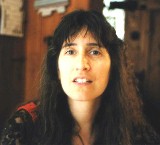 |
Egos and Epiphanies:
The Self-Realization of Amy Fradon
by Gary Alexander
|
An
epiphany is the sudden manifestation of a supernatural presence or
deity. "Epiphany" is also a word
Amy Fradon
uses to describe a
life-altering moment she experienced in a European death camp which
presented her with a such a soul-deep impact of self-realization that it
was all but equivalent to a physical apparition.
Fradon was at the Terezin (Terezienstadt) Concentration Camp
outside of Prague, a few years ago, while on a European tour as part of
Vanaver Caravan, the performance group she will be appearing with at the
Bardavon Opera House in Poughkeepsie on November 4th to perform their
celebrated Woody Guthrie tribute. As a solo musician, she had left
behind her long term musical collaboration with Leslie Ritter and two
separate solo album projects she had shelved as "somehow incomplete" but
precisely what was missing did not begin to become focused in her mind
until that wrenching experience within the haunted walls of that
star-shaped fortress of doom.
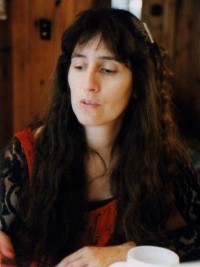 "We went to the crematorium at the camp and I stood in that room
with the big, black ovens where they still have the ashes of people,"
Fradon said. "Outside were fields full of buried bodies and I just had,
like an epiphany in there...I sobbed and sobbed and sobbed and there's
people filing by as I'm crying. I looked up at the huge windows at the
top of the building and had one of those 'miracle moments' where I knew
I had no reason, no business not putting myself and my music out in the
world...simply because I COULD...I wasn't being killed or imprisoned. I
had freedom. So, I really needed to take that freedom and live it."
"We went to the crematorium at the camp and I stood in that room
with the big, black ovens where they still have the ashes of people,"
Fradon said. "Outside were fields full of buried bodies and I just had,
like an epiphany in there...I sobbed and sobbed and sobbed and there's
people filing by as I'm crying. I looked up at the huge windows at the
top of the building and had one of those 'miracle moments' where I knew
I had no reason, no business not putting myself and my music out in the
world...simply because I COULD...I wasn't being killed or imprisoned. I
had freedom. So, I really needed to take that freedom and live it."
Terezin isn't the most infamous of Nazi death camps but it has a
special repute which Fradon could well appreciate. Prior to Hitler, its
only record as a facility for incarceration since its opening in 1780
was when it held the assassins of Archduke Ferdinand and his wife in
1914. Under the Third Reich, the little fortress found use as a prison
designated to protect the state from such "dangerous" elements as Czech
Jews, musicians, artists, writers, actors and independent thinkers.
Although the more than 97,000 who died there, including 15,000 children,
are dwarfed by the fatalities of other such camps, Terezin also served
as a staging area from which many others were shipped to
Auschwitz-Birkenau. For Fradon, as for many others, it remains an
overwhelming site.
Raised on a farm in a once rural area outside of Danbury,
Connecticut, Amy inherited an artistic flair from her father, Dana
Fradon, a well-known cartoonist for New Yorker magazine and
a mother who
illustrated for the Brenda Starr comic strip
and DC/Marvel Comics. She
had the "prerequisite piano lessons" as a child and enjoyed singalongs
of old popular songs with her dad, but found greater focus in ballet and
modern dance in formative years. It wasn't until a new college roommate
at NYU announced herself as a singer that Amy impulsively "joined the
band."
"When she said `I'm a singer,' for some reason, I said `I am,
too!'," Amy Laughs. "So, I was, from that moment on, because she said
`let's go audition for the coffeehouse' and I said `okay.' I was a dance
major. I had no inkling what it really meant. My boyfriend at the time
was Eric Parker (a Woodstock-based drummer for The Rhinestones, Joe
Cocker and other acts), so I was around music a lot but I don't think I
ever thought of myself as a singer."
Leaping into the water doesn't make you a swimmer, as Amy
quickly discovered.
"I didn't know how to sing a lick of harmony," she smiles with
tender memory. "I had to plug my ears on stage so I wouldn't be pulled
off the melody by her singing but I loved it and just became obsessed
with the details."
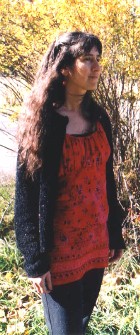 Fradon experienced another "miracle moment" when she arrived
in Woodstock for the first time with a friend and recalls; "The minute
we rounded the corner on Zena Road and I saw the mountains, my heart
just leapt in my chest. I knew I would be living here. It was just such
a `Yes!' moment."
Fradon experienced another "miracle moment" when she arrived
in Woodstock for the first time with a friend and recalls; "The minute
we rounded the corner on Zena Road and I saw the mountains, my heart
just leapt in my chest. I knew I would be living here. It was just such
a `Yes!' moment."
Of such moments destinies are forged and through her
connection with Parker, Fradon found herself "plopped into the midst of
the finest musicians in the area" as her course of musical discovery and
development continued. She soon found herself playing local clubs in a
"throw-together" band with Parker and an assortment of sessions players,
known musicians keeping busy between tours or talented unknowns trying
to keep ends together.
"I don't even know if we had a name," Fradon reflects. "We
used to play at The Lake, the old Whitewater Depot before it was The
Horseman. Robbie Dupree was in the band before he was `Robbie.' Cane
Roberts, when he was still Robert Athis and before getting famous as a
heavy metal guy, he used to be this sensitive, jive kind of player. Gail
Boggs of The Striders. Gary Bonner from The Turtles, (who used to write
songs for people like Bobby Darin in that megastar's most sensitive and
introspective period). I learned on the job doing those gigs."
As Fradon educated her euphonious voice, she became
acquainted with the region's musical community and began nurturing a
fledgling demand for her growing skills for effective harmonies by
delivering memorable performances on stage and in studio, working with a
profusion of local acts. She couldn't remember the name of the first
album she was enlisted to embellish but burst right into the harmony
part she sang as if it had been yesterday.
"I guess word spread and people called me for session work
because I was naturally a pretty quick study in the studio," Fradon
observes. "I wanted so bad to be a singer, I practiced like eight hours
a day and if someone in the studio pointed out something I wasn't doing
right, said `Amy, your pitch is off' or something, I'd go home and
obsess about it and work on it endlessly. I was determined never to go
back in and have it be like that again. I was just very exacting of
myself and, so, you do get good at it if you get like that...Though, I'm
not sure at what cost to my poor little nervous system or tormented
psyche."
Her diligence paid off as she joined the Marc Black Group
for her first steady schedule of gigging and began recording jingles
with Woodstock musician-producer Andy Robinson for Gimbel's and "some
mattress company." She also performed frequently with the Hoppen
brothers of Orleans, the Traum brothers, Maria Muldaur, Lucy Kaplansky,
Rory Block, John Sebastian, Pete Seeger, Ed Sanders' Fugs, the late Rick
Danko and other area illuminaries.
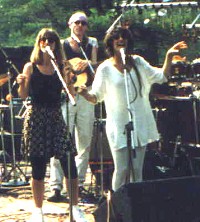
Leslie Ritter (left) with Amy Fradon
|
When Amy won a role in the Broadway musical Pump Boys and
the Dinettes, she was replaced in The Phantoms, another group she
appeared with regularly, by Leslie Ritter. Meeting Ritter at that time
would assume later significance as the pair united for a twelve year
partnership which would span seven albums as a duo and countless backup
roles for other musicians.
Ritter had worked in other bands with Phantoms' drummer
(and Fradon's former spouse) Dan Uttendorfer, who suggested Leslie as a
replacement while Amy was off to Broadway and the subsequent National
Touring Company's road productions of the successful musical in Houston,
Cleveland's famous Palace Theater and as a traveling troupe across the
country.
Although a veteran of a progression of school plays as a
child, Fradon adhered always with greater tranquility to the musical
aspects of the performance than to speaking through another's character.
"I'm way more comfortable singing than acting," she
reflects. "There's something about acting that feels very frightening to
me. I couldn't tell you why..."
Presumably, even something of a personal identification
with the character, as in Amy's memorable performance in the title role
of Ed Sanders' production of Cassandra, doesn't entirely quell her sense
of unease at the pretense of assuming an outside identity. The mythic
soothsayer of Ancient Greece might be viewed as a kind of New Age
character who was "gifted" by Apollo with an ability for accurate
prophecy which no one would take seriously and "Cassandra" was also a
nickname Amy's parents bestowed upon a daughter whose youth sprouted
many such foreboding predictions of coming events. It made her feel like
a natural for the role but, at the bottom line, it was the music and
lyric (some of which she delivered under Sanders' tutelage in the tongue
of the Ancient Greeks) which carried the day for her.
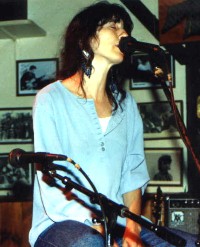 More than likely at the root of this tinge of unease
with the popular art of affectation is Fradon's own inherent gift of
intuitive expression. The calculation in deliberate facade, in
effectively portraying demeanor alien to your own, swims at different
sea level than Amy's close-to-the-surface spontaneity. The prethought
freedom of self expression from which the essence Fradon's talent
springs is evident in her self-assured, instantaneous and utterly
unselfconscious response to an interviewer's question; in her gesture of
hand and the motion and poise of her gaze. An emphasis upon the ease and
naturalness of reaction may swiftly be modified, enhanced or even
corrected in a blink but there is no mistaking where the emphasis
resides.
More than likely at the root of this tinge of unease
with the popular art of affectation is Fradon's own inherent gift of
intuitive expression. The calculation in deliberate facade, in
effectively portraying demeanor alien to your own, swims at different
sea level than Amy's close-to-the-surface spontaneity. The prethought
freedom of self expression from which the essence Fradon's talent
springs is evident in her self-assured, instantaneous and utterly
unselfconscious response to an interviewer's question; in her gesture of
hand and the motion and poise of her gaze. An emphasis upon the ease and
naturalness of reaction may swiftly be modified, enhanced or even
corrected in a blink but there is no mistaking where the emphasis
resides.
In dance forms, as in some styles of visual art, you do
not imitate, ideally, a given movement so much as you seek to become
that movement and in specific approaches to voice and rhythmic bodily
motion, which move in the same streams of musical grace and accent,
there is a goal of joining outside stimulus and interior response which
Fradon has mastered and, indeed, often teaches to others. Her "Vocal
Visionary Trainings" designed for people to "get deeply in touch with
their voice" are a byproduct of her own journey of self-discovery.
Singing is a profound experience for anyone who tries
it," Fradon smiles, secure in her own knowledge of the hidden dimensions
of voice and the deeper realms of uncompromised purity in vocal gesture
she strives to impart in her instructions to students.
Amy and Leslie had noticed in preparing Ritter to become
a Phantom that they "sang pretty well together, although it took a few
years before it jelled as `us'." Exploration of timing, interplay and
the complimentary tonalities of their voices in the mid-1980s developed
a distinct and sought after sound which provided record producers with a
"ready-made" vocal section and brought an abundance of sessions work.
Their own first album,
Crystal Song, in 1987 rippled notice of their
abilities, not with the suddenness of a meteorite falling into a pond,
perhaps, certainly far beyond previous perimeters.
Artistic development and self-discovery continued to
interlace through projects like Amy and Leslie's "transformational" work
with Kim Rosen and Cathy Malach (which used improvisational music and
visualization techniques with inter-species encounter experiences
between dolphins and humans through the Pathwork Center in Phoenicia).
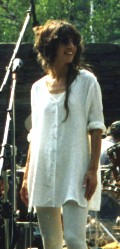
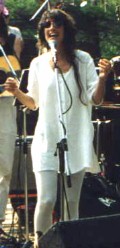 "Kim Rosen is a fine healer-visionary
therapist/workshop facilitator and she developed this thing they called
the Interspecies Connection, where she would bring groups of people-
sometimes arranged thru the Omega Institute, sometimes through the
Pathwork center- down to Florida to swim with the dolphins," Fradon
explains, recalling an earlier period of New Age spiritual development
inspired by scientific discovery (most notably by Dr. John Cunningham
Lilly, whose books on human and nonhuman intelligence had created
something of a sensation in the 1960s and 70s). "Based on all of the
feelings and experiences that came up for people, we'd go back and do
deep transformational work called the BRETHwork.
"Kim Rosen is a fine healer-visionary
therapist/workshop facilitator and she developed this thing they called
the Interspecies Connection, where she would bring groups of people-
sometimes arranged thru the Omega Institute, sometimes through the
Pathwork center- down to Florida to swim with the dolphins," Fradon
explains, recalling an earlier period of New Age spiritual development
inspired by scientific discovery (most notably by Dr. John Cunningham
Lilly, whose books on human and nonhuman intelligence had created
something of a sensation in the 1960s and 70s). "Based on all of the
feelings and experiences that came up for people, we'd go back and do
deep transformational work called the BRETHwork.
"They were incredible workshops," Fradon continues,
detailing how Malach and the duo had brought their own longtime interest
in therapeutic arts into the process. Leslie, Cathy Malach and myself
were the musicians, healing muses, I guess you would call it. We were
studying all sorts of alternative healing methods at that time,
bioenergetics or sorts, but this was Kim's own approach and we became
apprentices."
Before Bob Dylan sang of "The Disease of Conceit," John
Lilly detailed the eerie humbling of human arrogance within the close
presence of these intriguing oceanic mammals.
"Audacious in the extreme is this featherless biped
walking on dry land which is my species," wrote Lilly in
The Mind of the
Dolphin (1967). "His little, dry spirit has a great deal of gall to try
to push his way into the primal soup. In the face of the dolphin's
necessities, one quickly loses one's self-esteem."
Speaking of her experiences, Fradon articulates quite
similar sentiments; "I think there is a mystical connection between
humans and dolphins. There's something there. When you get into the
water with these creatures, all of a sudden there's this huge animal and
all sorts of things come up about how the dolphin treats you, ignores
you or loves you...Everyone loves whales and dolphins. It's like the way
we feel about dogs only it's much more intense. When you swim with a
dolphin, you're blown away..."
Using human experiences from such unusual Interspecies
exchanges in later workshop settings with Rosen; Fradon, Ritter and
Malach would provide improvisional sonic frameworks, akin to shamanic
rhythms and tones vocally supplied to help facilitate the unleashing of
unfamiliar emotional sensations and realizations. Focused breathing
exercises, organically flowing sound and hands-on stimulation were used
to guide inward seeking journeys during the sessions and inspired a pair
of "Delphys" CDS released in the early 90s with Fradon and Ritter front
and center.
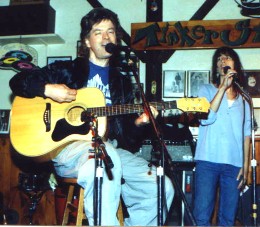
Tim Moore & Amy at Tinker Street Cafe
|
It might seem that the "Face The Music" invasions of
companies like General Electric and Panasonic to instruct corporate
personnel on the therapeutic values of writing blues songs about the
workplace (I kid you not- see
FaceTheMusicBlues.com) which
Amy participates
in might represent a counterpoint to her New Age excursions but she
finds the processes to be almost precisely the same. You loosen them up,
let them see themselves and show them how to get it out in a creative
form.
In speaking of various "new age' techniques, Fradon
mentions that she deplores the awkward terminology employed- "energy
work," "hands-on-healing" and the like but, if you've been out to clubs
in recent years in hopes of enjoying live music, you may have noticed a
pressing need to increase the self-awareness of a number of people. With
too little conscious time to spend with that inner realm, there is an
alarming trend of conditioned behavior in some audiences which blinds
some to the difference in dynamics between a live performer and an
insensate television screen or recorded rendition. But, don't get me
started...
As for performances recorded for posterity by Fradon
and Ritter, an impressive legacy can be found in the several further
albums of exquisite blending of songwork they released before parting
ways. Amy & Leslie on Alcazar in 1990, from which they also recorded a
music video of Amy's tune "Roll On" just before the VH1 channel
foolishly dissolved their acoustic programming. Take In Home
for
Shenachie Records in 1994 and others.
If the culmination of the Fradon-Ritter pairing
seemed abrupt, its development was much more subtle, as Amy saw it.
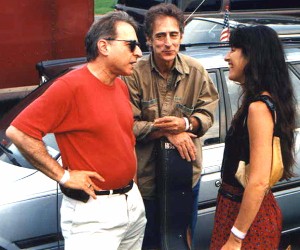
Happy Traum (left) & John Herald (center) talk
shop with Amy at an outdoor concert
|
"We were growing into different people," sighs
Fradon, noting how the pair had drifted into separating musical
perspectives in the latter years. "We were faced with having to record
another album for Shenachie and we could not figure out what to do. We
weren't writing together anymore and we were looking in different
directions. If we had tried to make a CD together, it would have been
all over the map." It was just time to part ways.
Fradon had begun writing her own songs, early on,
on the advice and encouragement of Bob Leinbach of the Fabulous
Rhinestones, who told her; "Ame, chick singers are a dime a dozen. Write
music. That's really important."
Taking Leinbach's words to heart, Fradon worked on
that "Eureka," with steady determination and dash of self recognition;
"I was young and I totally went `Yes! You're right!' and went to work on
it, realizing it sort of suits my own personality because I like to do
everything my own way."
Although Fradon teaches songwriting at Purchase
College in Tallahassee, she doesn't strictly consider herself a
"Songwriter," perhaps for lack of her own methodical formula.
On her own, Amy became involved in projects,
such as the Vanaver/Guthrie tribute (a project which released
Pastures
of Plenty-Songs of Woody Guthrie in February 2000, with Amy as featured
vocalist on several of the numbers), and other ventures. She also
continued performing and sought out individual talents to form her own
band. When you consider the rigors of staying busy with the performances
with the group, such as the one they will be making at
Bodles Opera House in Chester, N.Y.
on November 3rd and working with Bill and Livia
Vanaver along with Woody's daughter Nora of the Woody Guthrie Foundation
on the 25th Anniversary "Pastures of Plenty" Gala at Bardavon on
November 4th, hitting a fallow stretch in the recording her own albums
is a small wonder. But, also, a naturally disturbing one.
 Finding a doorway through that perplexing wall while weeping in a
chamber of human tragedy, in the presence of the ashes of musicians and
artists whose work had been cut short by tyranny, does indeed represent
a miracle moment of epiphany proportions. Amy returned from that
experience to record her exquisite solo album
Passion Angel and, in
doing so, found an edge of resolve she feels had been missing for her
entire life.
Finding a doorway through that perplexing wall while weeping in a
chamber of human tragedy, in the presence of the ashes of musicians and
artists whose work had been cut short by tyranny, does indeed represent
a miracle moment of epiphany proportions. Amy returned from that
experience to record her exquisite solo album
Passion Angel and, in
doing so, found an edge of resolve she feels had been missing for her
entire life.
"I feel like it gave me courage in a real way for the first time
in my life," she explained. "I knew the sense of it but it's not easy to
be an artist. People rip you apart; they ignore you; they reject you and
they idolize you. Whatever they do, somewhere in there, you've got to
find You and your relationship to your life and spirit. So, anyway, I
came back and started this album and I have not stopped since. It gave
me great courage and I think about it everyday."
Gary Alexander
is an independent journalist and scholar whose focus of
interests range through a variety of disciplines. Under various names,
he has written (and ghost written) upon history and current event;
science and technology, as well as music and the arts in books and for
national periodicals. While particularly attentive to the subtle and
complex impact upon cultural imagination and contemporary structures of
presumption which activity in the above mentioned topics tend to have,
Alexander treats his topics with a slightly more than occasional resort
to humor.
Posted on November 2, 2000
|

